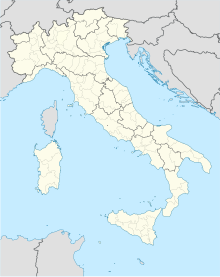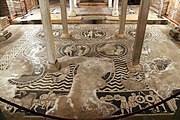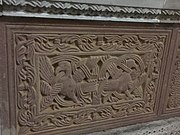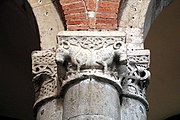History
San Savino was established as a Benedictine monastery in 903, located outside the then city walls. Much of Piacenza, and likely the original church here was ravaged by the Hungarian invasions in the early 900s. The attached church was initially dedicated to the twelve apostles, but Sabinus himself was buried here. The original construction appears to have been poor. In February 998, Pope Gregory V confirmed its right to freely elect its abbots. It was rebuilt by Bishop Sigifredo in 1005. The present layout is due to an 1107 reconstruction with later modifications, although it includes a few elements from the 903 edifice. The monastery of San Savino is mentioned in a 1132 bull of Innocent II The crypt of the church has 12th-century mosaics depicting the zodiac signs on a marine background. An ecclesiastical historian in 1651 describes a mosaic labyrinth in the church. [5] The presbytery has a contemporary mosaic showing battle scenes and a depiction of Christ.
In the 1500s, the church became property of the Hieronymite order, who reconstructed it. They remained in the monastery until 1810. In the 17th century, the church interior was decorated in a Baroque style, hiding much of the original Romanesque details. In 1631, the apse had a new choir installed. The nave was refurbished in 1687. In 1721, the present facade was built. Among the works of art in the church is a wooden crucifix and frescos from the 12th century and a 15th-century fresco in the presbytery depicting an Enthroned Madonna and child. [7]
In 1819, the hospice for "orphans and the exposed" (Ospizio degli Orfani ed Esposti) with 60 children was moved to the Girolamini monastery attached to San Savino. The hospice had been founded in 1573 by the then bishop, and run by the Somaschi order of clerics regular. They were affiliated with the parish church of San Stefano. The orphanage had been housed in the convent of Sant'Anna. [8]

Piacenza is a city and comune (municipality) in the Emilia-Romagna region of Northern Italy, and the capital of the eponymous province. As of 2022, Piacenza is the ninth largest city in the region by population, with more than 102,000 inhabitants.

San Miniato al Monte is a basilica in Florence, central Italy, standing atop one of the highest points in the city. It has been described as one of the finest Romanesque structures in Tuscany and one of the most scenic churches in Italy. There is an adjoining Olivetan monastery, seen to the right of the basilica when ascending the stairs.

The Church of St. Michael is an early-Romanesque church located in Hildesheim, Germany. It has been on the UNESCO World Cultural Heritage list since 1985 due to the before mentioned early-Romanesque architecture and art found within such as the Tree of Jesse and the now relocated Bernward Doors.

The Basilica of Sant'Ambrogio is an ancient Romanesque-style, Roman Catholic church in the center of Milan, region of Lombardy, Italy.
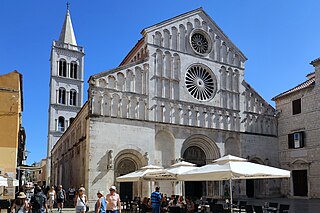
The Cathedral of St. Anastasia is the Roman Catholic cathedral of Zadar, Croatia, seat of the Archdiocese of Zadar, and the largest church in all of Dalmatia.

Padua Cathedral, or Basilica Cathedral of Saint Mary of the Assumption, is a Catholic church and minor basilica located on the east end of Piazza Duomo, adjacent to the bishop's palace in Padua, Veneto, Italy.
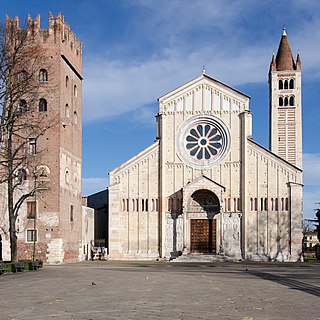
The Basilica di San Zeno is a minor basilica of Verona, northern Italy constructed between 967 and 1398 AD. Its fame rests partly on its Romanesque architecture and partly upon the tradition that its crypt was the place of the marriage of Shakespeare's Romeo and Juliet.

The Basilica of San Michele Maggiore is a Roman Catholic church in Pavia, region of Lombardy, Italy. The building, dating to the 11-12th centuries, is a well-preserved example of the Lombard-Romanesque style.

Piacenza Cathedral, fully the Cathedral of Santa Maria Assunta e Santa Giustina, is a Roman Catholic cathedral in Piacenza, Italy. The current structure was built between 1122 and 1233 and is one of the most valuable examples of a Romanesque cathedral in northern Italy. The dedication is to the Assumption of the Virgin Mary and to Saint Justina. It is the seat of the diocese of Piacenza-Bobbio.

Fiesole Cathedral, officially the Cathedral of Saint Romulus of Fiesole, is a Roman Catholic cathedral in Fiesole, Tuscany, central Italy. It is the seat of the Bishop of Fiesole and is dedicated to Saint Romulus.

Foligno Cathedral is a Catholic cathedral situated on the Piazza della Repubblica in the center of Foligno, Italy. The cathedral, built on the site of an earlier basilica, is dedicated to the patron saint of the city, the martyr Felician of Foligno, who was buried here in 251 AD. It is the seat of the Bishop of Foligno. It contains the cathedra for the Diocese of Foligno.

Basilica di Santa Maria Assunta is the principal church in the town of Aquileia, in the Province of Udine and the region of Friuli-Venezia Giulia, Italy.
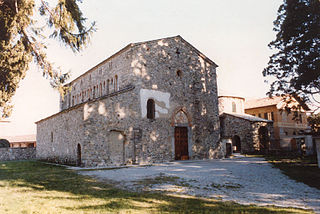
The Basilica di San Vincenzo is a church in Galliano, a frazione of Cantù, in Lombardy, northern Italy. An example of local Romanesque architecture, it was founded in 1007. The complex includes also a baptistry, dedicated to St. John the Baptist.

Otranto Cathedral is a Roman Catholic cathedral in the Italian city of Otranto, dedicated to the Annunciation of the Virgin Mary. It is the archiepiscopal seat of the Archdiocese of Otranto. The cathedral was consecrated in 1088. It is 54 metres long by 25 metres wide and is built on 42 monolithic granite and marble columns from unknown quarries. Its plan is a three-aisled nave with an apsidal east end. On either side of the west façade are two lancet windows.
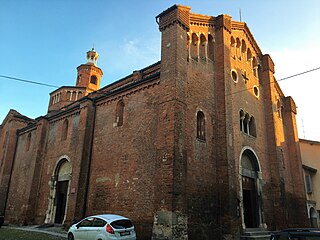
San Teodoro is a Romanesque-style Roman Catholic church in the town center of Pavia, Italy.

The Collegiate Church of St Florentius is a Gothic style, Roman Catholic collegiate, now parish church, in Fiorenzuola d'Arda, in the Province of Piacenza, region of Emilia-Romagna, Italy.

San Michele is a Romanesque, Roman Catholic church located on Via Mezzomerico #10 in the town limits of Oleggio, province of Novara, Piedmont, Italy.

The Basilica of Santa Maria at Pie' di Chienti was a former Roman Catholic monastery and church located in a rural site on the north bank of the Chienti river, just outside of the town of Montecosaro Scalo, in the province of Macerata, region of Marche, Italy. The church is also known as the Santissima Annunziata.

Siegfried, also Sigefred or Sigifredo, was the bishop of Piacenza from 997 until his death. He was a loyal and rewarded participant in the imperial church system and a notable builder in the city of Piacenza.
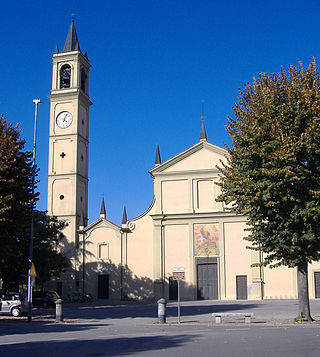
The Our Lady of the Assumption Church is a Catholic church in Caselle Landi, a small village in Italy.

